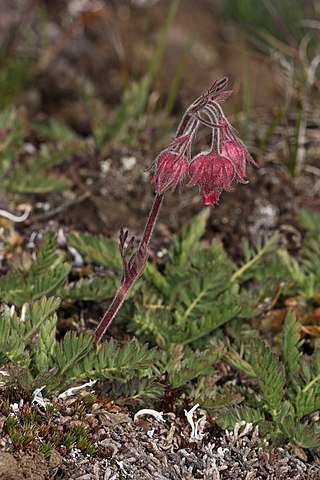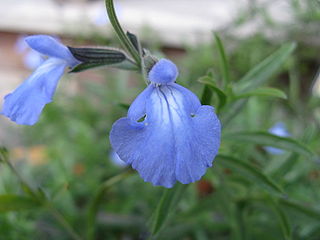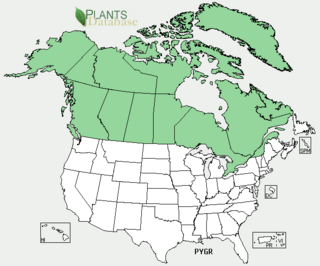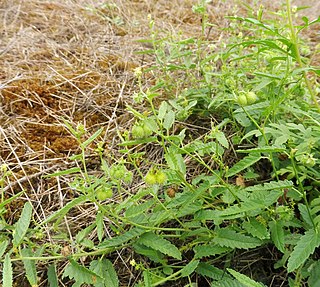
Rudbeckia hirta, commonly called black-eyed Susan, is a North American flowering plant in the family Asteraceae, native to Eastern and Central North America and naturalized in the Western part of the continent as well as in China. It has now been found in all 10 Canadian Provinces and all 48 of the states in the contiguous United States.

Allium vineale is a perennial, bulb-forming species of wild onion, native to Europe, northwestern Africa and the Middle East. The species was introduced in Australia and North America, where it has become a noxious weed.

Lycopodium clavatum is the most widespread species in the genus Lycopodium in the clubmoss family.

Rudbeckia laciniata, the cutleaf coneflower, is a species of flowering plant in the family Asteraceae. It is native to North America, where it is widespread in both Canada and the United States. Its natural habitat is wet sites in flood plains, along stream banks, and in moist forests. Common names other than cutleaf coneflower include cutleaf, goldenglow, green-headed coneflower, tall coneflower, sochan and thimbleweed.

Rubus strigosus, the American red raspberry or American raspberry, is a species of Rubus native to much of North America. It was often treated as a variety or subspecies of the closely related Eurasian Rubus idaeus, but is now more commonly treated as a distinct species. Many of the commercial raspberry cultivars grown for their fruit derive from hybrids between R. strigosus and R. idaeus; see Raspberry for more details.

Rudbeckia fulgida, the orange coneflower or perennial coneflower, is a species of flowering plant in the family Asteraceae, native to eastern North America.

Rudbeckia triloba, the browneyed or brown-eyed susan, thin-leaved coneflower or three-leaved coneflower, is a species of flowering plant in the family Asteraceae with numerous, yellow, daisy-like flowers. It is native to the central and eastern United States and is often seen in old fields or along roadsides. It is also cultivated as an ornamental.

Geum triflorum, commonly known as prairie smoke, old man's whiskers, torchflower, three-sisters, long-plumed purple avens, lion's beard, or three-flowered avens, is a spring-blooming perennial herbaceous plant of the Rosaceae family. It is a hemiboreal continental climate species that is widespread in colder and drier environments of western North America, although it does occur in isolated populations as far east as New York and Ontario. It is particularly known for the long feathery plumes on the seed heads that have inspired many of the regional common names and aid in wind dispersal of its seeds.

Symphyotrichum lateriflorum is a species of flowering plant in the aster family (Asteraceae). Commonly known as calico aster, starved aster, and white woodland aster, it is native to eastern and central North America. It is a perennial and herbaceous plant that may reach heights up to 120 centimeters and widths up to 30 centimeters.

Salvia azurea, the azure blue sage, azure sage, blue sage or prairie sage, is a herbaceous perennial in the genus Salvia that is native to Central and Eastern North America.

Solanum physalifolium, known as hoe nightshade, Argentine nightshade, green nightshade and hairy nightshade, is a species in the family Solanaceae. Native to Argentina, Bolivia and Chile, it is widely naturalized in Australia, New Zealand, Europe, western Canada and the north western United States. Solanum physalifolium has been widely but incorrectly known as Solanum sarrachoides, a different species. It has been listed as a noxious weed in the US states of Kansas and Michigan under this misapplied name.

Brickellia grandiflora, known by the common name tasselflower brickellbush, is a species of flowering plant in the family Asteraceae.

Stemodia durantifolia is a species of flowering plant in the plantain family commonly known as the whitewoolly twintip and purple stemodia. Stemodia durantifolia is native to the Americas, including Chile, Mexico, Texas, and the deserts of California and Arizona, and is often found in riparian habitats, preferring wet sand and rocks. It is a perennial herb producing a hairy, glandular, erect stem 10–100 cm (3.9–39.4 in) tall, with the toothed lance-shaped leaves found in pairs or triplets, attached to the stem with clasping bases. The inflorescence is a raceme of violet flowers, with each corolla held in a calyx of hairy, pointed sepals, and can often be found in bloom year-round. Although globally at low risk of extinction, Stemodia durantifolia is imperiled in California due to its rarity and threats from development.

Triteleia grandiflora is a species of flowering plant known by the common names largeflower triteleia, largeflower tripletlily, and wild hyacinth.

Oenothera macrocarpa, the bigfruit evening primrose, Ozark sundrops, Missouri evening primrose, or Missouri primrose, is a species of flowering plant in the evening primrose family Onagraceae, native to northeast Mexico and the south-central United States, where it is found in calcareous prairies and limestone outcrops.

Pyrola grandiflora (pronunciation , commonly known as Arctic wintergreen or largeflowered wintergreen, is a hardy perennial evergreen subshrub in the family Ericaceae. It is widely distributed in the Northern Hemisphere from temperate to tundra-like climates.

Hieracium longipilum, the hairy hawkweed, is a North American plant species in the tribe Cichorieae within the family Asteraceae. It is widespread across much of central Canada and the central United States from Ontario south to Texas and Louisiana. There are old reports of the species growing in Québec, but apparently does not grow there now.

Tragia betonicifolia, commonly called betonyleaf noseburn, is a species of flowering plant in the spurge family (Euphorbiaceae). It is native to North America, where it is primarily found in the South-Central region of the United States extending north into Kansas and Missouri, with disjunct populations east in Tennessee. Its typical natural habitat is dry areas with sandy or rocky soil, in glades, prairies, bluffs, and dry woodlands.

Penstemon secundiflorus, commonly known as sidebells penstemon, or orchid beardtoungue is a species of Penstemon that grows in dry forests, high plains, and scrub lands from Wyoming to Mexico. It is a herbaceous perennial plant that typically grows to a height of 20 to 50 cm and has narrow, lance-shaped leaves that are grayish-green in color. The flowers of the sidebells penstemon are tubular in shape and are arranged in a one-sided spike, with the blooms all facing the same direction, and for this reason was named "secundiflorus", which means "one-sided flowers". The flowers are most often delicate shades of orchid or lavender. It is sometimes used in xeriscaping, rock gardens, and wildflower meadows, and is well-suited to dry, sunny locations with well-drained soil.

Penstemon ambiguus, commonly known as the bush penstemon, pink plains penstemon, or gilia beardtongue is a species of Penstemon that grows in the shortgrass prairies and deserts of the western United States and northern Mexico. This bush like penstemon grows in sandy, loose, and creosote soils and is particularly known for the spectacular flowering show it produces, sometime seasons turning whole hillsides bright pink–white.





















